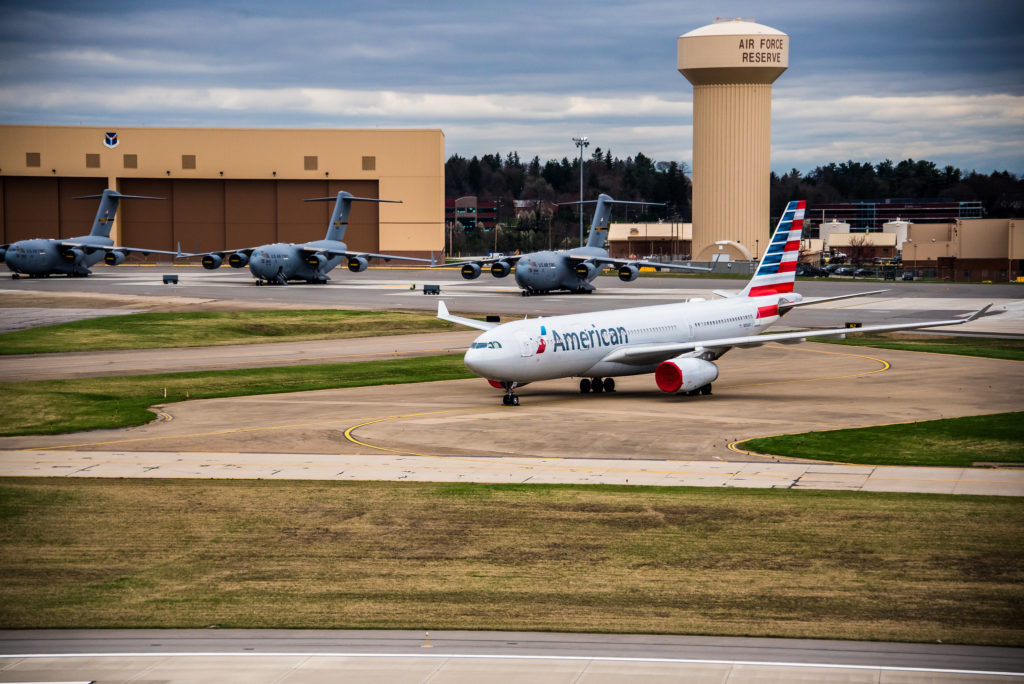These Planes Are Still Flying During the Crisis
Airlines forced to strategize which aircraft to use amid pandemic
By Natalie Fiorilli
Published April 13, 2020
Read Time: 3 mins
As the airline industry adjusts to plummeting passenger traffic levels, more than 2,000 planes are grounded nationwide.
Data provided by the flight tracking website FlightRadar24 shows that, in the past month, airlines experienced a roughly 70 percent decrease in the number of daily commercial flight operations worldwide.
By April 9, more than 2,200 aircraft—about 35 percent of U.S. airlines’ fleets—sit idle, according to data from Airlines for America.
Nearly 100 planes owned by American Airlines and Republic Airways are parked at Pittsburgh International Airport. The planes range from Republic’s Embraer E-170 regional jets to American’s Airbus A319, A320, A321 and larger, wide-body A330 aircraft, as well as their E-190 regional jets.
So, which planes are still flying?
Right now, it’s a relatively normal mix of narrow-body and regional aircraft flying, explained Rhett Morgan, an aviation consultant and former network planner for Southwest Airlines.
“It’s still about the same as last year at this time,” said Morgan. “It was likely more of an operational feasibility for now, but I do project that moving forward we are going to see more of the smaller, narrow-body aircraft and regional jets flying, based on demand.”
Examples of narrow-body aircraft include the Boeing 737, Airbus A319 and A320, which typically can hold between 100 and 185 passengers. Smaller, regional jets usually carry fewer than 100 passengers and are known for flying shorter distances, around 1,500 miles or less.
However, the most noticeable change can be seen in the number of wide-body aircraft parked.

An American Airlines Airbus A330-200 sits idle at Pittsburgh International Airport. (Photo by Beth Hollerich)
Wide-body aircraft, like the Airbus A330, Boeing 767 and Boeing 777, among others, are capable of operating international and domestic routes alike, including transatlantic flights. As airlines have nearly halted international flights, carriers including American Airlines are seeing approximately 90 percent decreases, year over year, in the number of flights operated on wide-body planes in April.
“The international flights are decimated,” said Bijan Vasigh, a professor of economics and finance at Embry-Riddle Aeronautical University. “Most of the wide-body aircraft are grounded right now, and they are shifting some of the smaller, regional planes to the domestic markets that are still operating.”
In addition to parking planes based on such factors as aircraft size, capacity and fuel efficiency, some airlines are planning to accelerate the retirement process of a number of aircraft models.
In March, American Airlines announced in a message to employees that it will ground its fleet of remaining Boeing 757s and Boeing 767-300s—50 aircraft in total. Other reports have suggested the airline may accelerate the retirement of its A330s and E-190s, some of which remain parked at PIT at this time.
Additionally, Delta Air Lines will accelerate the retirement of its MD-88 aircraft, which were set to stop flying by the end of the year.
“I think in today’s world, it’s all about survival,” Morgan said. “In the end, it all comes down to having the aircraft in the places they need and having the crew assigned to the planes they need to be flying right now.”
What is usually a significant moment for an airline, the aircraft retirement process, will now likely involve crew flying the parked planes to aircraft boneyards, Morgan noted.
“It’s really sad,” he said. “For the general public, it’s not as impactful. But for the aviation community, it is very sad. We call these aircraft the workhorses of the industry and they’ve been around 30 years. There’s a lot of memories there.”
Ultimately, the drastic reductions in air service and accelerated retirements have the potential to cause some airlines to have smaller fleets for the foreseeable future.
“I think acquisitions [of new aircraft] will be on pause,” said Morgan. “If we have a speedy recovery, and the airlines retire these aircraft, it’s not a one-for-one walk with new aircraft coming on right now, so they are going to be smaller. But, eventually they will want to grow back into the sizes they were before this.
“I think the entire landscape of the industry is going to change.”
Watch
This Next
Read
This Next





